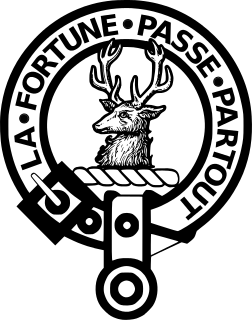
Earl of Minto, in the County of Roxburgh, is a title in the Peerage of the United Kingdom. It was created in 1813 for Gilbert Elliot-Murray-Kynynmound, 1st Baron Minto. The current earl is Gilbert Timothy George Lariston Elliot-Murray-Kynynmound, 7th Earl of Minto.

Clan Keith is a Highland and Lowland Scottish clan, whose Chief historically held the hereditary title of Marischal, then Great Marischal, then Earl Marischal of Scotland.

Clan Kennedy is a Scottish clan of the Scottish Lowlands.

Clan Nicolson is a Lowland Scottish clan. The clan claims descent from an Edinburgh lawyer who lived in the 16th century and from a distinguished line of Aberdeen merchants who preceded him. During the mid-1980s David Nicolson, 4th Baron Carnock was recognised by the Lord Lyon King of Arms as the chief of Clan Nicolson. Around the same time, a Nicolson who claimed descent from the Highland clan of "Nicolsons" historically centred on Skye, petitioned the Lord Lyon King of Arms to be recognised as chief of his own clan. The Lord Lyon King of Arms accepted this man's petition on the condition he took the surname MacNeacail. In consequence there are two Scottish clans with similar names—the lowland Clan Nicolson and the highland Clan MacNeacail.

Clan Anderson is a Scottish clan that is recognized as such by the Lord Lyon King of Arms. However, as the clan does not currently have a chief recognized by the Court of the Lord Lyon, it is therefore considered an armigerous clan. Variations of the surname are however considered septs of several other clans of the Scottish Highlands: The surname MacAndrews is considered a sept of the Clan Mackintosh and Clan Chattan, and also associated with the Clan MacDonell of Glengarry. The surnames Andrew and Andrews are considered septs of the Clan Ross.

Clan Buchanan is a Highlands Scottish Clan whose origins are said to lie in the 1225 grant of lands on the eastern shore of Loch Lomond to clergyman Sir Absalon of Buchanan by the Earl of Lennox.

Clan Lumsden is a Lowland Scottish clan.

Clan Moncreiffe is a Highland Scottish clan.

Clan Jardine is a Scottish clan of the Scottish Lowlands.
Clan Strachan is a Scottish clan originating from the barony of Strachan, in Aberdeenshire. The clan does not have a chief, therefore it is considered by Court of the Lord Lyon and the Stand Council of Scottish Chiefs as an Armigerous clan.

Clan Eliott is a Border Reiver Scottish clan.
Clan Straiton, also called Straton or Stratton, is a Lowland Scottish clan. The clan does not currently have a chief therefore it is considered an Armigerous clan.

Clan Rollo is a Lowland Scottish clan.

Clan Spens or Spence is a Lowland Scottish clan and is also a sept of Clan MacDuff.
Clan Strange is a Lowland Scottish clan.
Matthew was a 12th-century churchman residing in Scotland. He is the first man known to have held the position of Archdeacon of St Andrews, his first known ecclesiastical post. He occurs in this office in a document which can be dated to some point between August 1147 and June 1152. Bishop Edward, Bishop of Aberdeen, died in 1172 and Archdeacon Matthew was elected as the successor. He was consecrated on 2 April 1172.

Clan Forbes is a Highland Scottish clan from Aberdeenshire, Scotland.

Clan Cairns is a Scottish clan. The clan does not have a chief recognised by the Lord Lyon King of Arms, therefore the clan has no standing under Scots Law. Clan Cairns is considered an armigerous clan, meaning that it is considered to have had at one time a chief who possessed the chiefly arms, however no one at present is in possession of such arms. The arms of Cairns of that Ilk are blazoned as: Gules, three merlette Or.

Clan Walkinshaw is a Scottish clan. It does not have a chief recognised by the Lord Lyon King of Arms therefore the clan has no standing under Scots Law. Clan Walkinshaw is considered an armigerous clan, meaning that it is considered to have had at one time a chief who possessed the chiefly arms, however no one at present is in possession of such arms.

Clan Ralston is a Scottish clan. The clan is recognized as such by the Court of the Lord Lyon, but as it does not currently have a chief recognized by the Lord Lyon King of Arms it is considered an Armigerous clan.

















